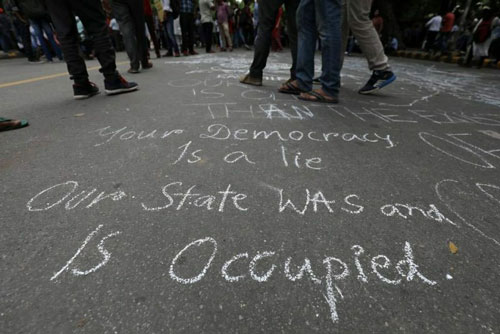New York
An article in a leading American newspaper depicted the misery and suffering of the Kashmiri people under the brutal Indian occupation, saying the disputed state has “fallen into a state of suspended animation.”
Headlined ‘In Kashmir’s Stillness, Hopes Wither and Houseboats Sink,’ the article in the New York Times said the disputed state had been “reeling for more than a year,” when India imposed a tight military lockdown in August 2019, imposed a communications blockade and arrested hundreds of people from all walks of life, especially the young.
“The streets are full of soldiers. Military bunkers, removed years ago, are back, and at many places cleave the road. On highways, soldiers stop passenger vehicles and drag commuters out to check their identity cards,” Times correspondent Emily Schmall wrote in a report from Srinagar.
“It’s a scene reminiscent of the 1990s when an armed struggle erupted and the Indian government deployed hundreds of thousands of troops to crush it,” her report said.
“Conflict in Kashmir, India’s only Muslim-majority region, has festered for decades. And an armed uprising has long sought self-rule. Tens of thousands of rebels, civilians and security forces have died since 1990. India and Pakistan have gone to war twice over the territory,” it said.
“Now, as India flexes its power over the region, to even call Kashmir a disputed region is a crime sedition,” the NYT report said, citing Indian officials.
Correspondent Schmall wrote, “Many say that the political paralysis is the worst it has ever been in Kashmir’s 30 years of conflict, and that people have been choked into submission.
Prime Minister Narendra Modi of India stripped the region of its autonomy and statehood in August 2019, and promised the move – which cancelled Kashmiris’ inheritance rights to land and jobs – would unleash a flood of new investment and opportunity for the beleaguered region.
“Half a million soldiers came, imposing the strictest clampdown Kashmiris have ever seen.The money hasn’t arrived. People say they are more scared than they have ever been. Political leaders from the wealthiest, most respected families in Kashmir, former elected officials who had worked to reconcile Kashmiris’ call for independence with India’s desire for unity were arrested and held for months,” she wrote.
“You can do this to pro-India leaders, you can do it to anyone,” the report quoted Mohamed Mir as saying from behind the counter of his father’s empty pashmina shop in downtown Srinagar.
“Kashmiris, who try to vent their anger online against the Indian government, are being slapped with terrorism charges. Many have been detained. Paramilitary forces appear suddenly. They arrived at the Khanqah of Shah-Hamdan, a Sufi shrine drenched in coloured glass and papier-mache dedicated to Mir Sayed Ali Hamadni, the Persian saint and traveler who brought Islam to the valley,” the NYT report said.
“In the evening, soldiers stood guard at the 6th-century Hindu temple on Gopadri Hill, Srinagar’s highest point, the Sankaracharya Temple, as muezzin calls to prayer from local mosques echoed across the still valley.
Kashmir’s economy is on the brink of collapse. In the past, even when gun battles between security forces and militants became pervasive, international tourists continued to throng Kashmir’s ski slopes, houseboats and artisan pashmina and papier-mache shops.
“Since Indian forces moved in, however, hardly any visitors have come,” the report added. A 700-year-old mosque remained open through civil strife and fires, but after the Indian government took control of Kashmir it was closed for months, the report said. “Its muezzin was locked out and prevented from giving the daily calls to prayer.”
“Fear is different and worse than at any time in the last 40 years,” Ghulam Hussain Mir, a businessman was quoted as saying.
“With no tourists coming to Kashmir, houseboat owners are suffering badly. The houseboats date to the British colonial era, a clever workaround to restrictions on foreign land ownership.
But the elaborately carved cedar vessels are in ill repair and many are sinking. Hard-pressed owners are unable to pay for fresh caulk,” the NYT report added.—KMS










